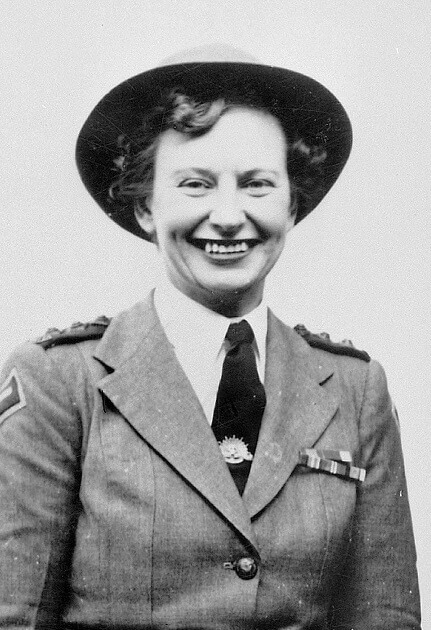Vivian Bullwinkel was one of the 65 nurses on board the Vyner Brooke. After it was attacked and sunk, Bullwinkel drifted for hours clinging to a lifeboat before she struggled ashore on Banka Island with other survivors.
Her story of survival was published in The Age, September 1945:

Vivian Bullwinkel, 1950.
Reproduced courtesy Australian War Memorial
When we got ashore from the Vyner Brooke men in the party decided the best way to protect us was to surrender peaceably to the Japanese. The Japanese took out tommyguns, set up a machine gun and ordered us into the sea. There was no mistaking their vicious intentions, so we ran madly into the waves.
As we were thigh deep in the surf they opened murderous fire, mowing us down like a scene I saw in a film as a child. Women around me shrieked, stiffened and sank.
I was hit in the left side, and fell unconscious in the water. I can't swim a stroke, but somehow I felt my body being washed about in the waves. I lost consciousness, recovered it, but, lost it again, I was never clear what was happening, but a number of times I felt I was being washed towards the beach. Then I found I was on the beach. Bodies of men and women were lying around me. The Japanese bayoneted the men's bodies, but left the women's alone. That is the only reason I am alive today. I lay still, partly because something told me I would be killed if I moved and partly because I did not care, anyway.
I lost consciousness, then woke again among the bodies. Hardly knowing what I was doing, I dragged myself into the jungle, where I think I fainted again through loss of blood.
All I remember is struggling to get water from a nearby spring. I think I must have lain unconscious for what I afterwards found was three days.
Vivian hid in the jungle for 12 days, caring for wounded British soldier, Private Cecil Kinsley. Starvation forced them to surrender and they were taken into captivity. Kinsley was sent to a camp in Muntok in the Indonesian province of Bangka-Belitung, where he died from his wounds.
Bullwinkel was reunited with survivors of the Vyner Brooke. Whilst she told them of the massacre, it was never mentioned again. No survivor and witness would have been allowed to live. Bullwinkel spent three and half years in captivity; she was one of just 24 of the 65 nurses who had been on the Vyner Brooke to survive the war.
A modest woman, with a stoic temperament, Bullwinkel reflected that her attitude to captivity differed from that of the other women. She said:
I went into prison camp in a very different frame of mind probably to the other girls because when I was out in the jungle I said all I want is to get back amongst my own people, I don't care how long I'm taken prisoner. So that when we began to feel a bit frustrated or feel when is this going to end, I'd remind myself of what I said . . .
When Vivian Bullwinkel returned home she devoted the decades after the war to nursing and honouring those who did not survive Bangka Island. She and fellow POW survivor Betty Jeffrey raised funds for a memorial. The Nurses Memorial Centre, a ‘living memorial’ to Australian nurses who had died in war, opened in Melbourne in 1949. Betty was its first administrator.
Vivian rose to become Matron of the Queen's Memorial Infectious Diseases Hospital, in Melbourne, served on the Council of the Australian War Memorial and as president of the Australian College of Nursing. Honours earned include the Florence Nightingale Medal, an MBE and the AM.
